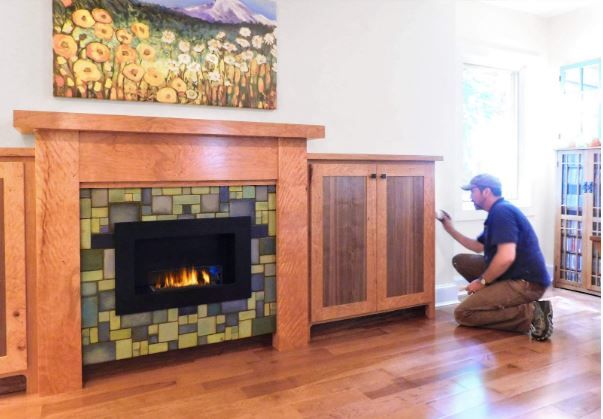It all started with a leap of desperation. Five years ago, I thought I had the perfect life. I had a great job working as a paralegal for a small-town attorney, who had also become a good friend. My husband Arthur had just finished building the first part of our dream home, and I also felt incredibly healthy and high-energy. Then suddenly my employer was diagnosed with fast-moving cancer, and she passed away soon afterward. Arthur had taken time off to build our house, so we had no income and had spent much of our savings on the house. The stress triggered the last phase of my undiagnosed thyroid disease.
It seems that my good health was an illusion - the excess energy was actually an early symptom of the disease. Within months I could barely get out of bed. And there were even worse symptoms: severe cognitive impairment, debilitating fatigue, severe depression, chronic pain and a bunch of other ailments.
I won’t bore you with the crummy details. Let’s just say it sucked a lot for both of us. Keep in mind as you read this interview that during the past five years my husband has not only done the physical labor for our businesses, but also run our household (doing the grocery shopping, cooking, cleaning, and so on). He’s amazing.
Anyway, in the beginning we set Arthur up as a handyman: just him, his truck, and his tools. And me answering the phone, which was the one thing I could still do.
How did you get your first three customers?
From Craigslist. It makes us laugh when we talk about it now. We would take the most awful jobs and we were wildly undercharging. It’s funny because we got more push-back at that ridiculously low price point than we get these days with our $10,000 bookcases.
That’s how we learned that it really matters where you advertise. Leads from Craigslist, Angie’s List, Yelp and so on tended to bring in the bottom-feeders, but we got many quality leads from optimizing our website for Google. So it’s okay to take whatever work you can get, at first, but you need to keep an eye out for the sources that bring you a better quality of customer. Now we get a lot of our customers on Instagram as well as Google.
And we also learned that you need to calculate your desired hourly rate and then triple it. At least. Especially in an industry which requires expensive tools. You might charge less than that when you’re trying to break into your field, but you need to start testing the ceiling on your pricing right away.
By the way, don’t worry if you get pushback on your price, at least to a point, because you’ll get more pushback if you’re not charging enough than you’ll get at a more appropriate rate. This may seem counterintuitive, but it’s because cheap people complain more. Focus on getting customers who appreciate good quality. You’ll know when you’re undercharging because your really nice customers will tell you so.
But we were so proud of our new business back then! I remember Arthur going out on a cold rainy Thanksgiving Eve night to fix a hole into someone’s attic for a laughably low fee. We have the luxury of turning down emergency calls like that now. In fact we refer all of our handyman work out to other people, but back then we photographed the work and showed it off.
So we really started at the bottom. But I built a simple website on Weebly and taught myself about SEO (I had plenty of time on my hands). And then I built a better website, still on Weebly, and since Arthur did such a great job he started to get excellent reviews on Google. This is another important lesson: quality and reputation are absolutely key to surviving. And make sure you have online proof of your awesomeness!
In fact, this is what grew the referral service I mentioned before. With so many great reviews and photos, we got more jobs than we could take on, so we’d refer them to other handymen we knew (or later recruited). If they got the job they’d pay us a referral fee on the honor system. It never did more than pay for my time, but it gave me the dignity of work, which meant a lot when I could barely stand up long enough to take a shower.
One day one of our handymen called me (he’s a big tough Army Reserve guy) and he was tearing up. He told me that when we recruited him as a referral partner, he didn’t know how he was going to pay his bills. And because of us he was able to support his family and even bought his little girl a bicycle for Christmas. I still tear up all over again when I think about that. When you’re sick like I was, you start to feel useless to the world. Helping Arthur and the other guys gave me purpose in life. And we learned another lesson: find a graceful way to turn down work you don’t want, and get your competition to pay you to let them do it. Everybody wins that way.
What is the weirdest customer request you’ve had?
We’ve had some doozies. Scraping out bat guano from an attic was probably the worst. I turned that one down. We didn’t even refer it to anyone.
In any business, it’s extremely important to learn what to turn down. You absolutely MUST have a positive attitude when you’re working this hard - it’s your greatest asset - and bad jobs will wreck that for you. So the first thing you need to build as a business owner is a “Spidey sense” for sucky work.
But as a matter of fact, most of our customers have been fantastic. One of our best clients was the woman who helped us launch our custom bookcase business. Arthur used to make furniture when he was younger, but we never really understood how to market it, so we had closed down that business.
And one of our customers saw it and commissioned him to build her a hutch in her kitchen. He did a great job, and we showed it off and got more work from there. Then I learned to draw models in Sketchup so our customers could preview their work, and I built a new website showcasing the furniture. Now we’re booked out about five months (and growing) and Arthur makes custom furniture all day long, which was always his dream.
Plus, I get to design cabinets for a living, so I’ve finally found a use for my art degree. (By the way, I draw 3D models as a freelancer, so let me know if you’d like some help with that. And since I’m just starting out on the freelancing, you can catch me while my rates are low.)
What were your family and friends’ first thoughts on your company?
They thought we were going to get rich from our handyman referral service. And maybe we could have, although there were certain aspects that would make it hard to expand. (It’s tough to get good insurance, for example.)
However, we’ve decided to wind it up and either close it or sell it instead. The handymen are all doing very well on their own now, and I need more time for freelancing and for our product launch. As I’ve recovered my health (which is relative since I still can’t walk much) I’ve started to dream about turning our cabinet business into an e-commerce business.
In my spare time I’ve tried to sell various dropshipping products like T-shirts, and although they all failed, I’ve learned a lot about marketing and online sales. Plus, I really think we’ve designed a really useful product.
Tell us more about this project you’re launching. Where did you get the idea for it?
It started because our customers care strongly about the way it feels when someone walks into their home. In fact, I’ve noticed that our best (highest-paying) clients tend to be incredibly gracious and welcoming people. Arthur will walk in to do the job and they’re offering him coffee, chatting with him, even making him lunch. Because that’s who they are… their homes really matter to them and they turn them into places of warmth and comfort.
And one thing they’re dealing with as they’re decorating their homes is the big “black hole” of a TV sitting in the middle of the wall. They don’t want their living rooms to be dominated by the TV. They want it to be a place where they can hang out, entertain their friends and do other things without being distracted by a big screen. So a lot of our custom projects revolve around hiding or framing the television.

That’s how I got the idea to make a cabinet that hides your TV behind art. This isn’t a totally new concept. There are a few other companies that do this... but most of those solutions are fairly expensive. They can cost over $10,000 and that doesn’t include installation.
So I’m designing a cabinet which will probably cost about half that (or even less if you follow our Instagram and get the pre-order discount when it’s released). And you’ll be able to hang it on the wall yourself. In fact, my goal once we build the prototype will be to install it alone, without Arthur’s help. If I can do it, so can you. (I hate power tools. A lot.)
How will you protect yourself from competition?
We’ve always done our best to ignore our competitors (unless we were putting them to good use). As far as e-commerce goes, we’re going to focus hard on delivering a quality product, and making sure people know what makes it good.
For example, we’re going to use real walnut wood in these cabinets, and we’re also testing several hand-rubbed no-VOC finishes that are safe for your family (and the craftsman who’s applying them). It’s amazing how many long-lasting and very safe products are out there. I can’t believe how many cabinet companies are still using toxic spray lacquer.
We’re also going to vent the cabinet using the same fans they use in industrial computer stacks, so your TV will stay cooler and last longer. And the art panels will be made in such a way that they’ll never warp or twist. Our goal is to build family heirlooms.
Maybe there are some people out there who can try to copy what we do - but we’re going to make darn sure there’s no one who can do it better. When you buy our TV cabinet, you won’t be getting something stamped out by an overseas sweatshop. You’ll be getting something made in the USA by people who really care about what they do. And if there’s one thing we’ve learned, it’s that our customers really appreciate quality and sincerity.
Where do you see Artisan Built-Ins in 5 years?
We ask ourselves that question a lot, but you can’t predict the future for better or for worse. Most of all we’re looking at the shorter timeline: hopefully build the prototype this spring if Arthur’s schedule allows, then launch this summer and see what happens. It feels like a magical time.
Our long-term goal is to create a “business” instead of a “job.” This is another distinction many new entrepreneurs don’t understand: if you are irreplaceable in your business, then you don’t have a business. You have a job without a boss, and that can be very nice, but you don’t have a saleable business. So that’s the point of our product launch. Our idea of wild success will be to put our competition to use again in the future… we’ll sell the cabinets and get someone else (in America) to build them. And Arthur can be our quality-control expert. He’s good at that.
What is the current revenue, total number of customers?
Well the handyman referral business topped out at about $10,000 a year, or about $2,000 per handyman. As I mentioned, it was never a full-time income, but the non-monetary benefits were great for me and for our business. We probably could have grown it larger, but I’m ready to move on.
I don’t have the numbers for the cabinet business in front of me, but it grosses around $7,500 a month and climbing. (We’re capped by not wanting to take on full-time assistants, which is why I’m trying to grow us in another direction.) I appreciate that this is not a huge number (yet), but it seems like a lot to us. We’re able to pay my ridiculous medical bills and save a bit for retirement. This year we’re even taking a beach vacation - the first one in years.

There’s no question about it: this is blue-collar work. But we love it. We’re in this business because Arthur is one of those guys that needs to work with his hands. He can’t be chained to a desk doing paperwork. A lot of handymen and cabinet makers are like that. There’s this idea that you don’t have to be too bright to be a handyman, but actually I’ve discovered that the guys we work with are some of the most creative and intelligent people you’ll meet. You have to do a lot of problem solving, and you’re constantly learning. And constantly moving, which is way better for you than office work.
As for the number of clients, that’s actually dropped, and the revenue per job has gone up. Specializing in cabinets has made a huge difference in the stress factor for this reason. Arthur used to average 2 to 4 clients a week on the handyman work, and that’s really hard because you’re jumping from job to job, and you have to adapt a lot on the fly. Now we have one or two clients a month. The paperwork has gone way down and it’s a lot easier to focus on one job at a time.
Do you have any podcasts or books you would recommend?
I like “Anti Fragile” by Nassim Taleb a lot. There are some great business lessons in that book, and one of the many fascinating concepts he discusses is “post traumatic growth.”
I make it sound easy and fun to grow our business, but it wasn’t always this way. We were doing it while I was terribly ill, so sometimes it was downright traumatic to be dealing with health issues and depression while being entrepreneurs. (By the way, I’m not suggesting that every person with a serious chronic disease should be out there starting a business. There is no shame in resting when you are sick, and not everyone has the resources we had.)
But back to post-traumatic growth, I think Arthur and I have both grown a lot from this experience. If I had never gotten sick, we might never have started this business, and in some ways we are “living the dream.” If I had it to do all over again, I wouldn’t!!! But bad experiences aren’t necessarily the end of the world. If you’re going through a bad time, if you’re tempted to end it all or walk away, have faith. Something amazingly good might still come out of it, if you just hang in there.
So keep trying. You might be surprised.
| Company Name: | Artisan Built-Ins |
|---|---|
| Founder: | Faith Teel |






